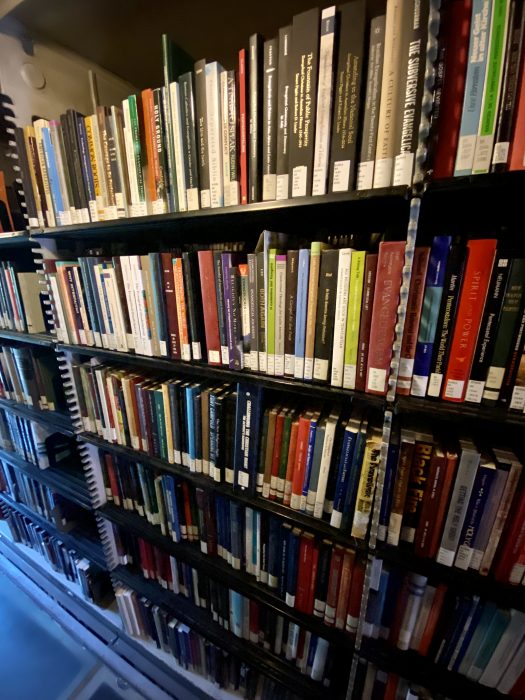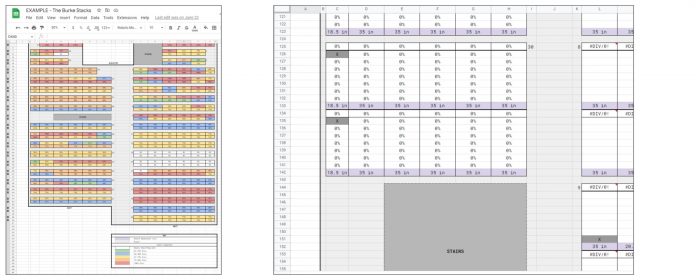Have you ever gone looking for a book in the Burke circulating collections, only to be met with a shelf so tightly crammed that retrieving the text you need feels like tug of war? Books can crowd! There never seems to be enough room! You’ve seen it in your homes, in your offices, in the “little library” your neighbor bolted to a sign post down the block. Change my mind!

While the inconvenience of pulling out a tightly shelved item is relatively momentary, the process of alleviating shelf congestion in the first place is…more involved. Falling under the umbrella of Stacks Maintenance, Shelf Shifting is the process of spacing books out across the shelves to allow for collection growth, proactively making space for items as more join the stacks. In other words, it’s a necessary protection against future tug-of-war scenarios.
This summer, I constructed a tool to assist with evaluating shelf congestion and planning for shelf shifting. I mapped the Burke stacks. By mapping, I mean that I created a visual representation of all the individual shelves in the stacks. There are over 11,000 shelves, by the way. And, yes, I used my fancy tool to figure that out as well.

Google Sheets offered a platform to both visualize the “fullness” of the shelves, while backing up these visuals with data. The data includes the size of the Burke’s holdings as well as the physical amount of space available for storing the books (both calculated in percentages of “fullness” as well as in linear inches). By estimating how “full” individual shelves are, the map automatically color codes bays (groups of shelves vertically). This color coding highlights areas in need of shifting as well as areas with more space where congestion can be relieved with shelf shifting.

Meanwhile, the data produced with mapping will allow the Burke staff to estimate the time and labor required to complete shifting projects of virtually any scale. Not only does this offer an opportunity to standardize how we allocate time and energy for Stacks Maintenance, but it also prepares the Burke staff to undertake larger shifting projects as items move Offsite in some areas and continue to grow in other areas.
So why all the hubbub over moving books around?
Ensuring that space is allocated for growth in a collection with over 700,000 on-site items, across 5 floors, is a gargantuan task not only in the physical aspect of moving books, but also in the planning for enough room to justify all that heavy lifting. It’s standard to plan for 5 years of growth when shelf shifting.
New acquisitions statistics assist in projecting growth. As expected, new titles cataloged with Library of Congress Classification (read more about the Burke’s other call number system here) overwhelmingly fall in the BR-BX range, including the subclasses: Christianity (BR), the Bible (BS), Doctrinal Theology (BT), Practical Theology (BV), and Christian Denominations (BX). These subclasses see around 10x the annual additions compared to the next highest areas of growth. Acquisitions fundamentally shape the character of the collection – they constitute the Burke’s character and identity. Stacks maintenance “makes space” and “holds space” for intellectual creations that the Burke Library is tasked with preserving. While the pandemic’s influence on the necessity and preference for eResources and virtual services is setting precedents for how libraries approach collection development, the obvious but fundamental fact remains: a library is also a home for good ole fashioned print books.
Since I graduated from Union Theological Seminary (MA Systematic Theology) in 2018, many books still occupy nearly the same spots I remember they did four years ago. There’s a comfort in this consistency, especially because my appetite for new publications is equally matched with a reverence for the tried and true titles that continuously return to nourish my and so many others’ research.
The glacial growth of the Burke’s collection is often imperceptible, but it is always happening. For a library that specializes in the field of theology and contextually related areas of study, there may be an assumption that the Burke is overwhelmed by aging tomes. But this is far from accurate. Making space for new ideas in theology is precisely why the Burke will always grow and change over time: space for newer titles like Digital Theology: A Computer Science Perspective and Christianity and COVID-19: Pathways for Faith – titles that were likely not even imaginable when the Burke first opened.

In limited physical space, the maintenance of the Burke’s collections calls for efficient and practical solutions. Mapping the stacks provides yet another tool for conceptualizing the size and character of the Burke’s holdings. It pairs well with the other data available to us, promising that the work of making space will keep the shelves decongested for longer. Fancy spreadsheets aside, the paramount goal is to ensure that, at the end of the day, one might go to the shelf where we’ve promised the book is located, find the item, and it will slide pleasantly off the shelf. No tug of war required. -BH